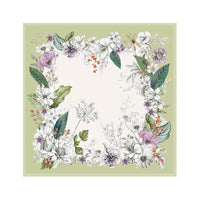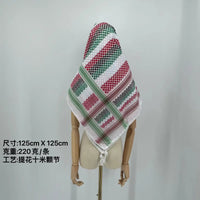The keffiyeh is not merely an accessory; it is a powerful symbol of Palestine and its resilient spirit. This iconic black and white patterned scarf has deep historical roots and has evolved to represent the Palestinian cause on a global scale.
Origins and Significance
Originating from Bedouin communities and local farmers in Palestine, the keffiyeh was initially a practical garment used to shield against the harsh desert environment. Its lightweight cotton fabric and intricate patterns carried meaningful symbolism:
- The fishnet pattern represented the connection between Palestinian sailors and the Mediterranean Sea.
- Bold lines symbolized the trade routes passing through Palestine.
- The olive leaf pattern embodied the strength, resilience, and perseverance of Palestinians, as well as the significance of olive trees to their culture.
From Garment to Icon
During the 1930s Arab revolt, the keffiyeh transcended its original purpose and became a symbol of Palestinian resistance. Rebels and revolutionaries wrapped it around their faces to conceal their identities and evade arrest. The British authorities attempted to ban it, but in a nationwide protest, all Palestinians began wearing it, making it impossible for the authorities to identify the rebels.
In the 1960s, Yasser Arafat, the former president of Palestine, further elevated the keffiyeh's status by wearing it to all his public engagements. His distinctive style of draping it around his head, with the tailend gracefully flowing over his right shoulder, symbolized a map of Palestine before the Nakba.
A Symbol of Unity
The keffiyeh gained even more prominence in the 1970s when Leila Khaled, a revolutionary freedom fighter, wore it as a headscarf and encouraged Palestinian women to do the same. This fostered a sense of solidarity, transcending gender and age. During the Intifadas in 1987 and 2000, people across the Middle East wore the keffiyeh to show support for Palestinians against the Israeli occupation.
Fast Fashion and Controversy
As the digital age and late capitalism took hold, the keffiyeh's design was co-opted by many fashion brands. This commercialization was met with criticism from those who felt it diluted the scarf's original meaning. Palestinian fashion designer Omar Joseph Nasser-Khoury described the keffiyeh as symbolizing "dispossession, systematic displacement, extrajudicial killings, and oppression." He viewed its use by designers divorced from this context as irresponsible and exploitative.
A Compelling Visual Emblem
Despite these controversies, the keffiyeh remains a compelling visual emblem of the ongoing struggle for justice, freedom, and self-determination among the Palestinian people. It is worn by Palestinians and their global allies as a tangible expression of unity and resistance against oppression.
Today, as people around the world protest for the rights of Palestinians living under constant attacks from Israel, they don the keffiyeh—a symbol of Palestine and its resilient spirit. Its core significance remains deeply rooted in the preservation of cultural heritage, the promotion of awareness, and the cultivation of a collective identity shared by Palestinians worldwide.





